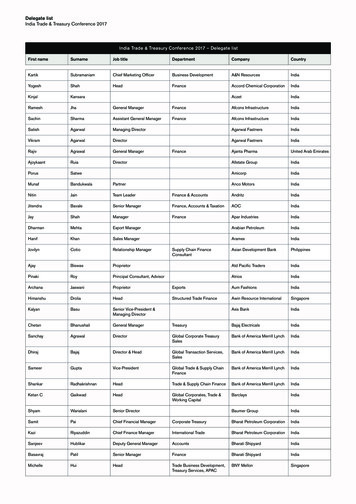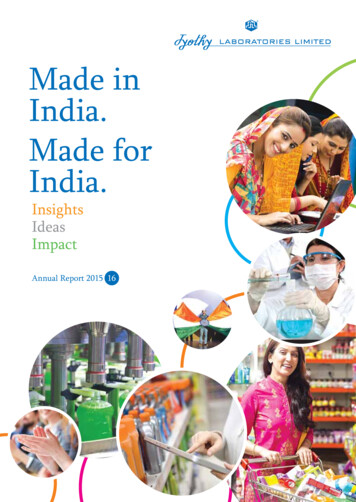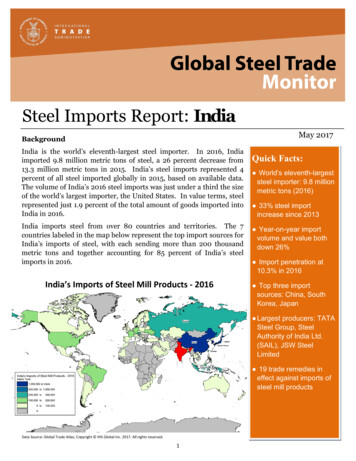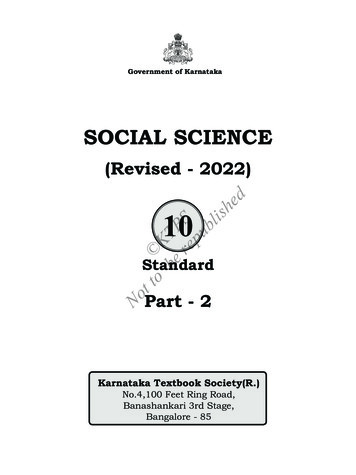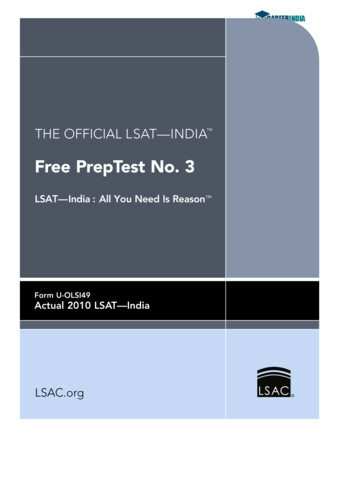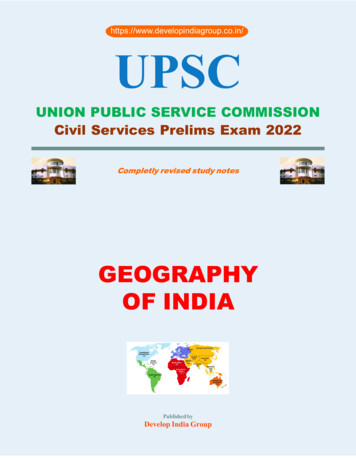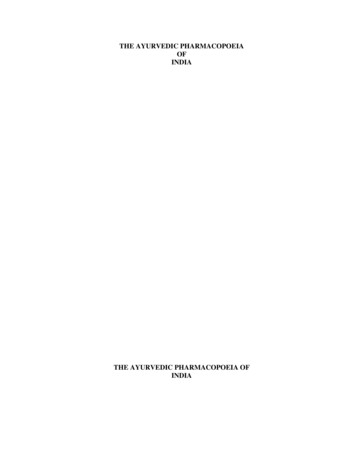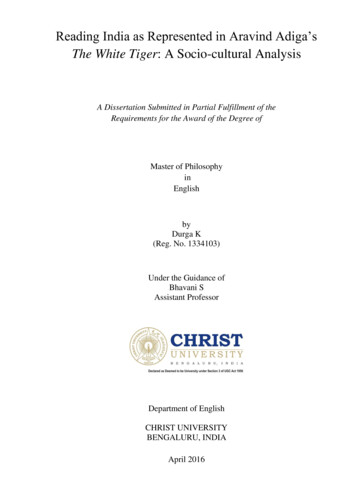
Transcription
Reading India as Represented in Aravind Adiga’sThe White Tiger: A Socio-cultural AnalysisA Dissertation Submitted in Partial Fulfillment of theRequirements for the Award of the Degree ofMaster of PhilosophyinEnglishbyDurga K(Reg. No. 1334103)Under the Guidance ofBhavani SAssistant ProfessorDepartment of EnglishCHRIST UNIVERSITYBENGALURU, INDIAApril 2016
Reading India as Represented in Aravind Adiga’sThe White Tiger: A Socio-cultural AnalysisA Dissertation Submitted in Partial Fulfillment of theRequirements for the Award of the Degree ofMaster of PhilosophyinEnglishbyDurga K(Reg. No. 1334103)Under the Guidance ofBhavani SAssistant ProfessorDepartment of EnglishCHRIST UNIVERSITYBENGALURU, INDIAApril 2016
Approval of DissertationDissertation entitled Reading India as Represented in Aravind Adiga’s ‘The White Tiger’: ASocio-cultural Analysis by Durga K, Reg. No. 1334103 is approved for the award of the degreeof Master of Philosophy in e:Place: BengaluruSealii
DECLARATIONI, Durga K hereby declare that the dissertation, titled Reading India as Represented in AravindAdiga’s ‘The White Tiger’: A Socio-cultural Analysis is a record of original research workundertaken by me for the award of the degree of Master of Philosophy in English. I havecompleted this study under the supervision of Ms. Bhavani S, Assistant Professor, Departmentof English.I also declare that this dissertation has not been submitted for the award of any degree, diploma,associateship, fellowship or other title. It has not been sent for any publication or presentationpurpose. I hereby confirm the originality of the work and that there is no plagiarism in any partof the dissertation.Place: BengaluruDate:Durga KReg No. 1334103Department of EnglishChrist University, Bengaluruiii
CERTIFICATEThis is to certify that the dissertation submitted by Durga K (Reg. No. 1334103) titled ReadingIndia as Represented in Aravind Adiga’s ‘The White Tiger’: A Socio-cultural Analysis is arecord of research work done by her during the academic year 2013-2015 under my supervisionin partial fulfillment for the award of Master of Philosophy in English.This dissertation has not been submitted for the award of any degree, diploma, associateship,fellowship or other title. It has not been sent for any publication or presentation purpose. Ihereby confirm the originality of the work and that there is no plagiarism in any part of thedissertation.Place: BengaluruDate:Ms. Bhavani SAssistant ProfessorDepartment of EnglishChrist University, BengaluruSignature of the Head of the DepartmentDepartment of EnglishChrist University, Bengaluruiv
AcknowledgementFirst and foremost, I oblige my sincere gratitude to the supreme power that guides andleads each one of us, the God Almighty, to have showered His blessings on me throughout myendeavor of doing my M.Phil. research. I sincerely thank His gracious to have placed my workunder the scrutiny of the most respectable teacher whom every student wish to follow as herrole model, Dr. Sushma V. Murthy. I express my heartfelt gratitude to Dr. Murthy for theinvaluable time she spent scrutinizing my paper, her valuable suggestions, critical judgementsand words of motivation.I express my gratitude to my guide Ms. Bhavani S. for her guidance. I also gratefullyplace on record my sincere thanks to Ms. Shobana Mathews and Ms. Sreelatha R. for theirvaluable inputs which helped me better my work. I also owe my sincere gratitude to the MPhilcoordinators Mr. Joshua G. and Mr. Joseph Edward Felix to have scheduled my presentationson time and to have promptly sent me all the vital information regarding my submission.Also, I take this opportunity to convey my gratitude to Christ University, the Dean ofHumanities and Social Sciences Dr.John Joseph Kennedy, and the Head of the Department ofEnglish Dr. Abhaya N.B. to have given me the opportunity to be a part of Christ University. Ialso thank all the faculties under the Department of English, who had guided us through ourcoursework Ms. Renu Elizabeth Abraham, Mr. Biju I.P., Mr. Padmakumar and Dr. AryaAiyappan.I also express my sincere gratitude to my family and friends who bore with me duringthe most stressful of times. Their patience, endurance and words of motivation have alwaysbeen my driving force.v
AbstractThe research titled Reading India as Represented in Aravind Adiga’s ‘The White Tiger’:A Socio-cultural Analysis provides a critical analysis of Aravind Adiga’s The White Tiger. Theresearch aims at interpreting the socio-cultural frame of India as represented in The White Tiger.Adiga in the work portrays the socio-political and cultural India of the twenty-first century andpresents the life of a low-born man caught up in the politics and polity of the territory. Throughthe protagonist who acts as the mouthpiece of the writer himself, Adiga lays bare the sociocultural world of contemporary India.With the backdrop of the realities of the two contrasting images of India- the envisionedIndependent India of post freedom movement and the modern India of the rich- Adiga voiceshis concerns over the ‘othering’ of the poor by the rich in the contemporary India. He projectsthe class and caste systems as the imperial barricade for democratic socialism and economicequality which results in the victimization of the poor. The penniless being the powerless, thepoor sustains as the objects of exploitation by the elite capitalist class. With the context set,Adiga projects the voice of the neglected as a counter to the roaring economy of the nation.However, The White Tiger’s demeaning projection of the country made it a widely critiquedwork. The text’s poignant projection of the country as the dark India and its eventual baggingof the Booker Prize made many scholars consider the work as tactically marketing a dark Indiaimage as a saleable commodity to the widespread readership.Nevertheless, the researcher holds the view that although the essentialist notions of theThird World poverty and ‘the text’ as the real India need to be resisted, the existence of a darkless privileged side of India cannot be denied. The hegemonic class and caste structures and theideological positioning extant in the society, reinforce subjectivity and inequality making lifevi
vulnerable. Hence, to initiate any change in the existing scene, an acknowledgement of itsexistence is of prime importance.The problem the researcher undertakes to study in the research – Reading India asRepresented in Aravind Adiga’s ‘The White Tiger’: A Socio-cultural Analysis – is the influenceof socio-cultural conditions in shaping an individual. The problem is chosen with the intentionof drawing attention to the psychic traumas an individual undergoes while struggling to copewith his/her life conditions in the politically and ideologically constructed present day India.The study attempts to read the behavioural patterns of the textually projected society and itscharacters interpreting it as a reaction to their socio-cultural background, using the sociologicaltheory of anomie as laid down by Emile Durkheim and Robert Merton.The study considers the text as a commentary on the often veiled absurdities of theIndian socio-cultural set-up and it's likely threats. The thesis argues that a society in its attemptto condition an individual eventually constructs the individual morally or immorally,problematically or unproblematically; as ideological or anti-ideological entities. The thesisstudies the images of contemporary India as represented in the text, its socio-cultural systemand the survival status of its neglected masses and analyses how the socio-cultural factors affectan individual and how one tackles these conditions. The research method used in this study istextual analysis.Keywords: Culture, mythology, class and caste stratification, ideology, conditioning, devianceand anomie.vii
ContentsApproval of gmentvAbstractviChapter 1: Introduction1Chapter 2: India and The White Tiger: A Thematic Analysis17Chapter 3: Deviance and Anomie in The White Tiger37Chapter 4: Conclusion55Select Bibliography63viii
Chapter 1IntroductionIndia is a land of diversity with a variety of languages, dialects, social groupings, castesand cultures. It is also the largest functioning democracy with its regular and freely contestedelections. The philosophical and cultural heritage of India dates back to the Aryan civilisation,4000 years ago, which still have its deepest imprints in the society. Every Indian has a stock ofstories of myth and history imbibed onto his consciousness as his cultural heritage; aconsciousness of the past which he readily abides by even in the present. The present India,adding on to its diversity, can be called as an amalgamation of two Indias, the urban and therural. The urban cosmopolitan India is ever developing with its modern industries, nationalpolitics and foreign policies, the national media, the major universities, businesses, andscientific and technological developments. The rural, on the other hand, remains more or lessunchanged, blanketed with illiteracy, unemployment, poverty and poor standards of living, butstill blindfolded by the ideologies of myths and traditions. A thought-provoking image of thetwo Indias can be seen in Aravind Adiga’s The White Tiger.Aravind Adiga is the fifth in the line of Booker Prize winning writers from India, theothers being V.S. Naipaul, Salman Rushdie, Arundhati Roy and Kiran Desai. Being born inChennai and having completed his schooling in India, Adiga migrated to Australia where hecontinued his education at the various universities like Columbia University, New York andMagdalen College, Oxford. Adiga began his career as a journalist interning at The FinancialTimes and later became a correspondent for The Times. His acquaintance with the real worldaround as being a journalist, and his life and education outside India, are two major influencesidentifiable in his works of fiction. His communion with societies that hold no class barricades
Durga 2against its people made him ruminate over the stringent hierarchical system that India sustains.Also, his watch on the working class lives around intrigued Adiga contemplate deeper, the resultof which was his entry into the literary field. He stepped in as a literary figure with his debutnovel The White Tiger which won the 2008 Man Booker Prize. His other works Between theAssassinations (2008) and Last Man in Tower (2011) also perch on the themes of India- thevarious societal issues, the life here and its many problems.The plot of The White Tiger is weaved around the life of the central character BalramHalwai. Balram Halwai is a young man who hails from one of the dark villages of India calledLaxmangarh. After having been taken out of school, despite his intelligence and smartness,Balram starts his life as a worker in a tea shop breaking coals and wiping tables. His interest inthings considered out of his limits makes him lose his job. He thus migrates to Dhanbad, a bettertown, gets trained as a driver, and the Stork family appoints him as a driver-cum-servant. Whenthe America-returned son of the Stork leaves for Delhi, Balram too gets to accompany him asthe chauffeur of his Honda City. Though Mr. Ashok is a kind and gentle master to Balram, hishypocrisy and guilefulness anger Balram. He finds Ashok too as mean as his landlord fatherand gets rid of him by murdering him. Balram soon journeys further to another city in the southand sets up his start-up there with the stolen money, positioning himself as a successfulentrepreneur, and calls himself Mr. Ashok Sharma.Published in 2008 and set in contemporary India, detailing events as can be related tothe present political set-up, The White Tiger lays bare the socio-political world of everydayIndia; rather a dark side of India. Through the protagonist Balram Halwai, Adiga frames thework as a nativist narration of the nation, showcasing the socio-political world of contemporaryIndia. With the backdrop of the two contradictory images of India - the highly sophisticatedIndia of the rich and the vulnerable India of the poor, Adiga voices his concern over theDarwinian struggle the poor are engaged in here. The hegemonic ideologies of the rich usereligious myths and traditions as the tools to condition the poor for exploitation. Halwai’s rural
Durga 3India is a territory of darkness, a land of poverty, feudalism, fraudulence, unemployment, childlabour, despair and full of misery.The researcher in the study, argues that a society in its attempt to condition an individualeventually constructs the individual - morally or immorally, problematically orunproblematically; as ideological or anti-ideological entities - a reflection of which can beidentified in Adiga’s representation. Precisely, the researcher identifies Adiga’s India and itsinhabitants, with the extremities in their behavioural patterns, as an outcome of the socialconditioning practiced on them in the hierarchically positioned socio-cultural India. Theresearch views the text as a product of its society that possess a duality in itself; the twocontradictory images of India. The thesis, having analysed the various underlying themes andmajor issues discussed in the text, states that The White Tiger is a commentary on the oftenveiled absurdities of the Indian socio-cultural set-up, and it's likely threats. Also, the writer’schoice of a low-born man as his mouthpiece protagonist to attack the absurdities of the Indiansocio-political and cultural scene has also led the researcher frame the above-stated statementas the thesis statement or research question. The writer’s use of the first person narrativetechnique in his attack presenting the narrative as a nativist narration of the nation is alsoconsidered in framing the research question.The various studies on the text have explored the different possible aspects of the text.The White Tiger was a well-acclaimed work both commercially and critically for its bagging ofthe Booker Prize and its poignant projection of India. The Booker Prize committee found thenovel as a grabbing narrative on a man’s quest for freedom and the terrible cost of that freedom.They commented the novel as attempting to give a literary voice to those often left unheard the poor (The Financial Times 2008). The themes of slavery, the quest for freedom andescapism that seem to surface in the novel made reviewers compare it with the emancipatoryslave narratives of Ellison, Richard Wright and Frederik Douglass. Elizabeth Sarah Glady in“Shifting Indian Identities in Aravind Adiga's Work: The March from Individual to Communal
Durga 4Power” describes the novel as employing the motif of “the worth of the individual” fromEllison, Richard Wright and James Baldwin (1). Sara D. Schotland in her study on Adiga’s TheWhite Tiger and Richard Wright’s The Native Son makes a comparative analysis of the twonovels as she finds a “Manichean duality” of “rich/ master/ powerful” and “poor/ servant/oppressed” reflecting in the two works (1). She examines the extent to which the elements ofpoverty, despair, frustration and humiliation figure in the novels and the use of crime as aresultant reaction to it though they are set in different cultural setups and timelines. Althoughat a first glance, neither of the works fit in the usual postcolonial mould with The White Tigeremploying a native master and The Native Son with it’s setting in the US, she studies the twotexts in a postcolonial perspective. Schotland finds an unbridgeable chasm between themarginalized, impoverished populations and the dominant wealthy elites mimicking colonizerssurfacing in both the works.Adiga’s India in which The White Tiger is set is a land of poverty, corruption, powerhierarchies and stratification. The status of democracy in the world’s largest democracy is ahighly questionable element in The White Tiger. William Ryan Brown’s “De-Democratisationand the Novels of Aravind Adiga” analyses the de-democratic state of the country that Adigaprojects. Ryan Brown finds a system of slavery existing as more predominant than democracyin Adiga’s India. Brown states that the system of slavery that Balram identifies is “the GreatIndian Rooster Coop” (Adiga 149) and, his escape from the coop is only illusionary as thedemocracy is itself de-democratised. In his analysis of the two novels of Adiga, The White Tigerand The Last Man in Tower, Ryan Brown argues that the “two novels function in tandem todemonstrate the phenomenon of de-democratization occurring in contemporary liberaldemocracies”(7). He suggests resistance as the way to clear the space for authentic democracy.Ryan finds Adiga’s master metaphor of the rooster coop, a critique of India’s political andeconomic structures (7). The researcher finds Ryan Brown’s views helpful in analysing thesocio-cultural status of the represented India.
Durga 5Entrepreneurship is another major theme in The White Tiger. Haitham Hind’s“Discourse of Entrepreneurship in The White Tiger” is a critical examination of Adiga’s takeon entrepreneurship in India which he mouths through the sarcastic tongue of Balram Halwai.Hind here examines Adiga’s critiquing of entrepreneurship in India by analysing Halwai’savatar as the advocate of entrepreneurship. According to Hind’s analysis, Halwai’s viewsappear to be contradicting the idea of entrepreneurship as a way to freedom and self-dependencefor the common man. According to Hind’s study entrepreneurship here is just another waythrough which the system reproduces itself. Analysing Balram Halwai’s autobiographicalnarrative, Hind discusses on the nature of entrepreneurship that further exploits the dominatedclasses.Dr. Sasikanth Reddy in “Unselfing of the Self in Aravind Adiga’s The White Tiger”finds the divide between the haves and have-nots that Adiga portrays in the text as a truedepiction of the harsh realities of India. He finds the scenes of corruption and poverty thatharness the noble democracy as authentic. He finds Adiga’s work as an attempt to uncover thedark realities behind the veil of the booming India image. Dr. Sasikanth Reddy finds the novelinteresting and energetic and as a real portrayal of the complex Indian society. He finds thecharacterisation extremely realistic with a powerful voice of the underclass echoing throughoutthe text.Adiga’s attack on the Indian politics and polity depicting it as a land of corruption anddarkness was immensely critiqued both nationally and transnationally as in the case of DannyBoyle’s Slumdog Millionaire. However, Ana Christina Mendes considers The White Tiger asan unravelling of the subsumed Dark India to the global literary front. She questions thepremises that underpin the most vehement critiques directed at the novel; on the one hand asAdiga's work offering a creative shift from Salman Rushdie's, and on the other hand on hischaracterization strategies as presenting a class reprove fashioned with an ‘inauthentic’ reOrientalized title character.
Durga 6Interestingly the projected ‘dark India’ led Sudhir K. Arora question the authenticity inAdiga’s depiction of the nation and its political system as corrupt and erring in “AravindAdiga’s The White Tiger: A Political Feast”. Arora vehemently opposes Adiga’s views and thehailing of the text for its projection of a ‘dark India’ for the Western gaze. He rejects Adiga’sfocusing on the backwardness of the nation alone projecting it as dark and faulty. Arora arguesthat every system has its faults, and there is no flawless system ideal enough to be replaced withsince the real fault is not with the system but with the people who operate it. However, it isworth considering that when the governing people are biased and corrupt, the governing systemtoo can become biased and corrupt under which only the unprivileged and neglected suffer asreflected in O V Vijayan’s Saga of Dharmapuri. As Adiga himself expressed in an interviewto The Guardian, he feels it as the responsibility of writers like him “to highlight the brutalinjustices of society [The White Tiger] is not an attack on the country, it’s about the greaterprocess of self-examination” (“Roars of Anger”). On his projection of the class divide in Indiahe writes; “ class and the big divides we have in the world today between the better-off andthe worse-off, it doesn’t get written about much to me, it is the most pressing concern aroundtoday” (qtd. in Reddy 156).The White Tiger attracted careful studies initiating revolving discussions on realism,faithfulness, authenticity and the potential of the novel, describing the work as brutal, blunt,stark, and harrowing. Adiga’s sketching of his characters too invoked serious distaste amongthe critics as they find the portrayals unrealistic and melodramatic. Amitava Kumar as hereviews in The Hindu finds Adiga’s characters “utterly cartoonish, like the characters inBollywood melodrama”. He finds Adiga’s presentation of ordinary people “not only trite butalso offensive” (Kumar). For Kevin Rushby, Adiga’s characterisation seems as “Dickensiangrotesque” (Rushby). Alan Davis finds the existential facts being used like a “dagger todramatize the Darwinian nature of life in India for the poor” (Davis 169). For him, Halwai is anarrator who “cooks up droll self-serving portraits and tells us how India’s tangled, extended
Durga 7families oppress individual initiative as much as they provide subsistence-level support inreturn for fealty” (Davis 169). Dr. Bhagabat Nayak, on the other hand, considers the work asa narrative of “unremitting realism”. In “Contextualising Aravind Adiga’s The White Tiger inPostcolonial Paradigm” he interprets Balram’s letters as true accounts of India, which we denyacknowledging. He finds the neurotic behaviour of Balram as the outcome of the povertystricken life he lives.Reviewing the varied perspectives on the text the researcher views that, even though thenotion of the Third World as a land of misery or darkness and the image of a text as ‘the real’country need to be rejected, the existence of a dark less privileged side of India cannot beignored. To initiate any change in the system, an acknowledgment of its existence is of primeimportance. The research, considering the heterogeneity in every society, studies the differencesin the behavioural patterns of Adiga’s characters, from the villainous anti-social hero to theideological minor characters. The objectives of this research are:i)To analyse the images of contemporary India, its socio-cultural system and thesurvival status of its neglected masses as presented in the text andii)To analyse how the socio-cultural factors affect an individual and how one tacklesthese conditions.The research uses the sociological theory of anomie as its methodology of research and textualanalysis as its method. The social disintegration, lawlessness and the breakdown of cultural andnormative structures, giving prominence to materialistic goals resulting in deviant behaviours,well illustrates the ensuing anomie in The White Tiger’s social structure.Anomie is one of the most influential twentieth-century theories on the study of societyformulated and developed by the sociologists Emile Durkheim, Robert K. Merton and others.In general, anomie refers to lawlessness, normlessness, irregularity or confusion. In religiousterms, anomie is considered as guilt and assault to holy things (Heydari 1086). Emile Durkheimrepresents anomie as an unhappy, asocial condition generated by an absence of moral regulation
Durga 8or norms and, as a deep and enduring threat to the society (Law 14). As Durkheim states inAnomic Suicide, “no living being can be happy or even exist unless his needs are sufficientlyproportioned to his means [and] if nothing external can restrain this capacity for needfulfilment it can only be a source of torment to itself leading to a state of perpetual unhappiness”(qtd. in Bagley 110). Promoted by the goal of insatiable monetary gain, individuals thoughmaterially well–off, resort to despair or abnormal illegitimate rebellion. In Durkheim’s viewwhile poverty forces the individuals to be modest and restrained, wealth is a source of tormentdeveloping insatiable demands or greed in them (Law 14). In Durkheim’s sense anomiedevelops from a lack of moral regulation and can be prevented with strengthened moral codesand regulatory norms (Law 17).Durkheim’s concept of anomie as the decline of sacred institutions and moral authoritywas later countered and developed by the later theorists like Robert K. Merton. As Law puts it,Merton gave an innovative twist to the concept of anomie as the imbalance that exists betweenunequal social structures and the universal value of social success. Merton uses anomie theoryin analysing social structure and makes a distinction between cultural aspirations and socialaspirations. Merton states anomie as the resultant product of the imbalance between the twofundamental components of society- cultural structure and social structure. As Merton says,monetary achievement and social position have become the cultural aspirations of the modernworld. And since, the means to achieve them are not distributed egalitarian among social classesnot everyone gets the opportunity to attain the cultural goals of success. The unequaldistribution of means along with equal emphasis on achieving cultural aspirations, cause a kindof pressure in certain members of the society which has serious consequences. Those withinadequate legitimate means to acquire social success, such as the poor, may pursue deviantstrategies to acquire success, even if this means criminality. The aberrant emergent behaviouris a symptom of dissociation between culturally prescribed aspirations and socially structuredavenues for realising these aspirations.
Durga 9Merton developed a paradigm of social deviance based on the actor’s acceptance orrejection of cultural goals and the institutionalized means for reaching these goals. Merton’sanalysis describes the social structure as accountable for deviant behaviour. An example of thiskind of deviance is the behaviour ensuing from the limiting of aspirational goals by thehierarchical elements of the social structure (Bagley 111). In this case, the lower classindividuals resort to deviant behaviour because of their inability to reach the middle-class goalson account of the unequal socio-economic and cultural structures. The lower class youth’saspirations like the achievement of middle-class material standards, are not limited but aremoderate and are clearly defined. For him, the social structure is not lacking in constraint butis over-constrained which prevents his reaching of goals. Since the access to legitimate meansdiffer depending on one’s position held in the social structure, while the goal of material successremains the same, anomic pressure is found to be stronger for the socially disadvantaged strataof society in Merton’s terms. Meaningless, powerless and distrust feelings and money fetishismare manifestations of anomie in an individual’s behaviour.The concept of anomie has long been used and applied in different disciplines andcontexts in different ways. Christopher Bagley in “Anomie, Alienation and the Evaluation ofSocial Structures”, tries to analyse and validate the use of the three concepts in sociologicalliterature. Bagley examines the extent to which it is legitimate to derive an evaluation of socialstructures from a description of them. In his analysis, Bagley refers anomie as “a lack of ethicalprecision in society about the conduct of individual roles - a normative weakness of thecollective life which allows different normative standards to conflict” (116). Bagley’s studyidentifies that in the case of anomie, the individual has no precise normative goal and fails toidentify any normative constraints on his means of goal achievement. He follows no normativeguide nor any normative reference group to restrain his actions. In his analysis of his lifeconditions he finds himself alone and alienated, which will eventually lead to an anomicbehaviour developing in him (Bagley 119). As Durkheimian theory states, for the anomic
Durga 10individual the society that he inhabits lack any strict regulations or moral conducts and fails toobserve any strict boundaries between what is right and what is wrong. It is a lawless, normlesssociety where only the cultural goals have significance while the means to achieve them lacksany value (Bagley 119). When explained in Merton’s perspective, the actor seems free to choosea variety of means which often involve deviant reactions. In a Durkheimian sense, the actor’sacts of deviance are part of his anomic state (Bagley 119).Arash Heydari et al. in “Revising the Assessment of Feeling of Anomie: Presenting aMultidimensional Scale” attempts to build a multidimensional scale of anomie for Iraniansociety. Their study describes anomie as a state of the mind and a set of attitudes, beliefs andpersonal feelings which make the person feel that his surrounding is full of chaos and confusionwhich does not bear any regularity or systematic rules. For the anomic person, the norms thatregulate behaviours are weak and vague and the moral principles are collapsed. Anomieencompasses alienating from society and social institutions, a sense of disappointment,powerlessness and distrust to authority and society. In Merton’s views, aspirations have its deeproots in culture, and the most important of the cultural aspirations are money and wealth(Heydari 1089). Fetishism of money develops in the individuals as monetary assetsencompasses progress in economic achievements. Fetishism of money stays as one of the mostimportant causes of anomie which Heydari et al. evaluated in their quantitative analysis.Stephanie Thiel in “Global Anomi
novel The White Tiger which won the 2008 Man Booker Prize. His other works Between the Assassinations (2008) and Last Man in Tower (2011) also perch on the themes of India- the various societal issues, the life here and its many problems. The plot of The White Tiger is weaved around the life of the central character Balram Halwai.

